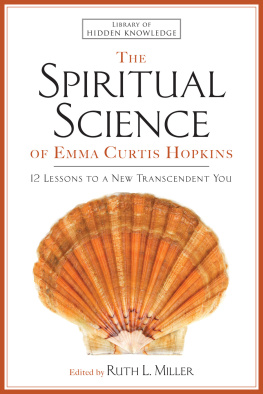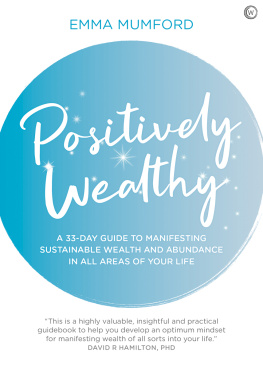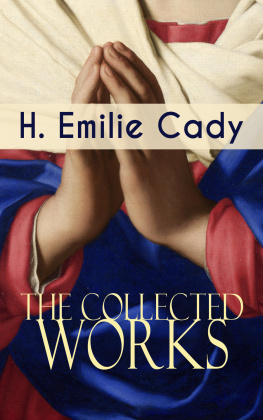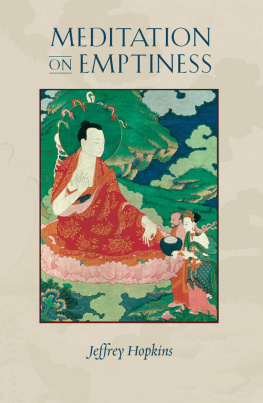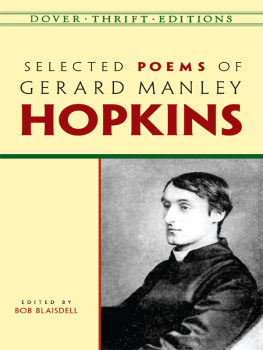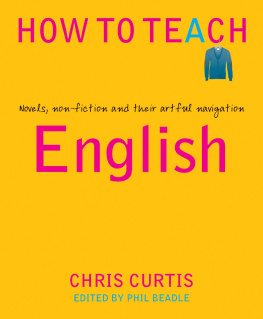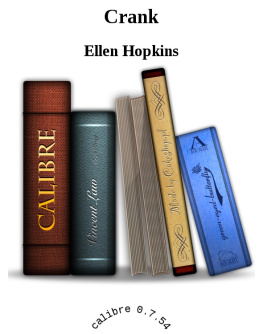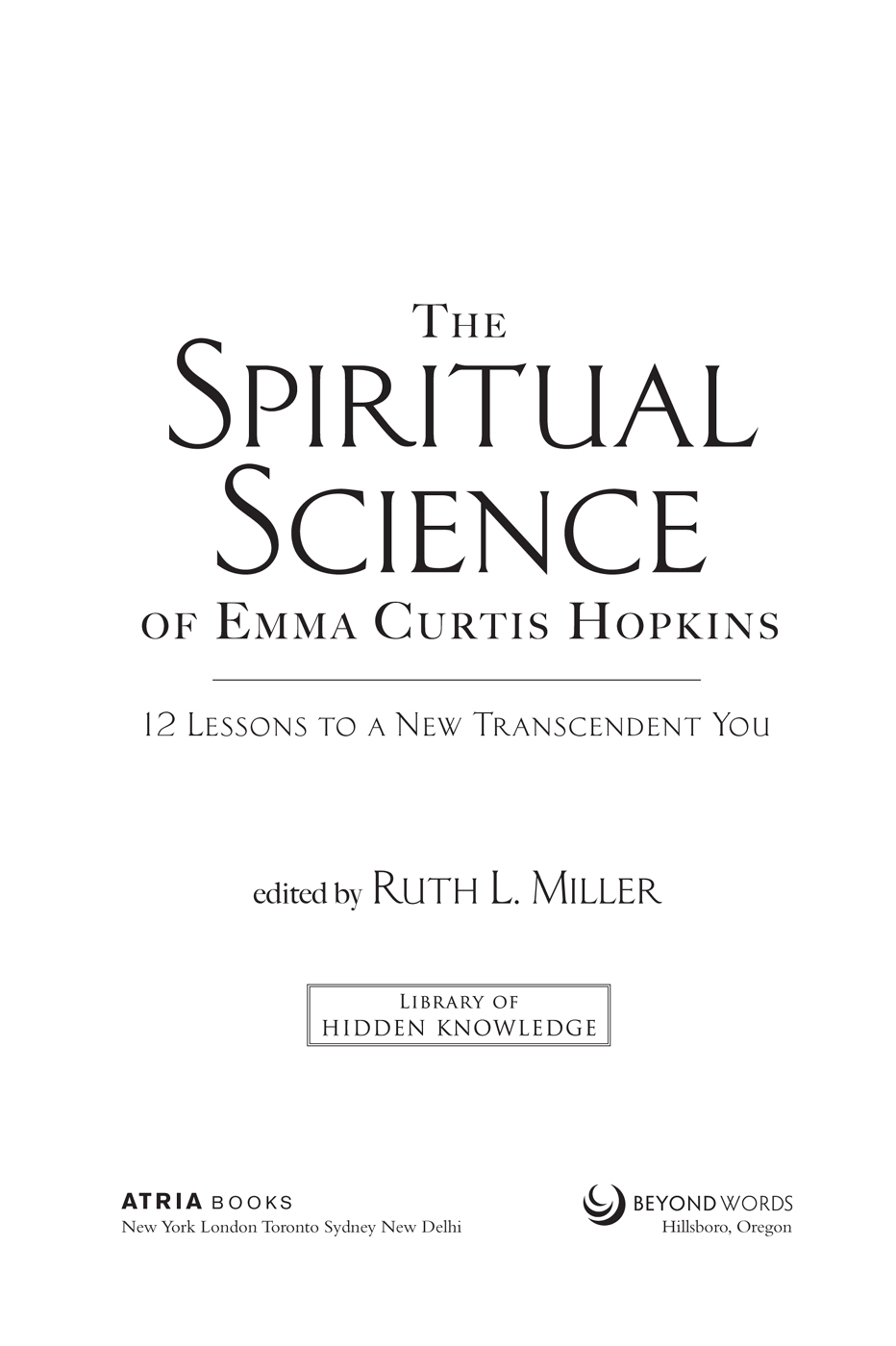Thank you for downloading this Atria Books eBook.
Join our mailing list and get updates on new releases, deals, bonus content and other great books from Atria Books and Simon & Schuster.
C LICK H ERE T O S IGN U P
or visit us online to sign up at
eBookNews.SimonandSchuster.com
C ONTENTS
N OTE FROM THE E DITOR
T his book is the seventh in the Library of Hidden Knowledge, a series of books originally written by philosopher-teachers who were famous in the late-nineteenth or early-twentieth century. Weve chosen specific texts by each of these authors and translated them into guides for living a healthy, prosperous life in the twenty-first century, providing summary points, modern examples and scientific explanations, and exercises to support their text. Then weve followed our translation with the authors original text. Our hope is that having read through the modernized language and format, the reader will better comprehend the complex prose and antiquated references that were normal for the authors and readers of that time.
Like the other authors in this series, Emma Curtis Hopkins was famous for both her lectures and her writing during her lifetime and beyond. Also like the others, she spoke and wrote in flowery prose and referred to many ancient and contemporary sources that she assumed her listeners were familiar with. She also used the only form of the Christian Bible available to her, the King James Version, and often followed its complex sentence structure.
To make her ideas more accessible to modern readers, weve generally simplified her text by shortening sentences and adding headings and subheadings, using the New International Version for biblical quotes (with occasional use of other versions if the language was clearer). Weve also expanded her use of other religions scriptures and updated the examples she used to illustrate her points.
Most of the books in this series were originally lectures that were later turned into essays and published by their authors, and this is no exception. The material in Esoteric Philosophy: Deeper Teachings in Spiritual Science is what Hopkins taught her advanced students and turned into a book late in her life so that they would have a guide when she was no longer teaching. This book was designed to help people who had explored the basic teachings from her earlier works and classes, such as those found in Florence Scovel Shinns The Game of Life and How to Play It , and were ready to take their understanding and practice to a new level.
Hopkins may well have been the most influential teacher of what nineteenth-century psychologist William James called the religion of positive thought, which is now known as the New Thought movement. Her twelve-step process was the basis for the organizations that became known as Unity, Divine Science, and Religious Science (Centers for Spiritual Living).
Because it is such a powerful tool for getting beyond our societys limited ideas about who we are and what were capable of doing, thousands of people whove used it have seen a change in their experience. And people who do her practice faithfully for several weeks have generally found that their health, relationships, and finances shift to healthier states. Those who not only do the process for themselves but share it with others have become powerful healers and teachers in their own right, as the existence of so many branches of the New Thought movement testifies.
In part, this is because Hopkins was a teacher of science and mathematics first and a metaphysician only after the observed evidence proved its effectiveness. Her logical process provided a bridge between the scientific method applied to observable phenomena and the purely intuitive experience she came to call high mysticism. As a result, students from all walks of life, from engineer to minister, from housekeeper to college professor, were able to follow her teaching and experience powerful results.
Still, Hopkinss writings were often difficult to comprehend. She offered a view of the world and our place in it that was based in ideals and absolutes, and she used language in a unique way. What others called God she might call the Absolute or the Eternal or the Infinite Abiding or any of forty or more terms. What others thought of as most important, such as ones circumstances, she saw as only indicative of past thought patterns that could be easily negated. What others assumed to be limited she would describe in the broadest of terms, saying, for example, mind instead of the mind to help the student step outside habits of limitation.
Her unique way of thinking and speaking helps the reader expand beyond normal thought processes, and weve attempted to maintain her style, though where it leads only to more confusion, weve replaced it with a more familiar form. Throughout this book, weve made every effort to give you the essence of her remarkable approach to life and human potential.
We hope you find these teachings as valuable as so many thousands have before.
G ETTING THE M OST FROM T HIS B OOK
As with all the books in the Library of Hidden Knowledge, we recommend reading the first half of the bookthe modern translationand then scanning the second halfthe original textto find the parts that leap off the page. The ideal next step is to do the exercises in the first half, using the authors original text as additional support in the process. Then, reading the original (and Hopkinss other works) carefully will be much more meaningful.
With Hopkinss lessons, though, theres another level to be aware of. The first six lessons apply to our personal lives and development; they are how she would have us start our day. Ideally, we would read and practice lesson 1 on Monday mornings, lesson 2 on Tuesday mornings, and so forth, through Saturday.
After youve gone through the book as a whole, you may find, as so many have already, that using her lessons in this way is a powerful method for advancing your spiritual life.
I NTRODUCTION
E mma Curtis Hopkins is called the teacher of teachers in the New Thought movement because, literally, every founder of every tradition in the movement studied with her or one of her students. Charles and Myrtle Fillmore, founders of what is now called Unity Worldwide, were among her first students. Ernest Holmes, founder of the Institute of Religious Science and the Centers for Spiritual Living, was her last. In between were the Brooks sisters and Malinda Cramer, founders of Divine Science, the Rix sisters, founders of the Home of Truth Spiritual Center, and hundreds of others.
Hopkins was an extraordinary teacher whom all her students loved. The eldest daughter of a Connecticut farmer who lost his arm in the Civil War, she was one of the young women who took over the teaching positions that had been vacated by the young men who went to fight in that war. She taught mathematics, science, and literature in girls schools and high schools until she married an equally brilliant teacher named George Hopkins and bore their son, John. Then, being a married woman in that time and place, she was no longer considered fit to teach in a school, so she taught her younger sister and son until he reached his teens and went to the Merchant Marine Academy around 1890.
Hopkins was also a scholar. She loved mathematics and ancient literature, having read Pythagoras in the original Greek, and studied the writings of the early Christian mystics in the original Latin. From references in her texts, it also appears she was able to read German and understood the difference between the Aramaic spoken at the time of the Roman Empire and the Hebrew used in the Jewish temple and Torah. As her interest in religion and mysticism grew, she also read the Tao Te Ching, the Zend-Avesta, the Egyptian Book of the Dead, the Quran, the Bhagavad Gita, the Upanishads, and as many of the Buddhas sutras as she could find.
Next page
